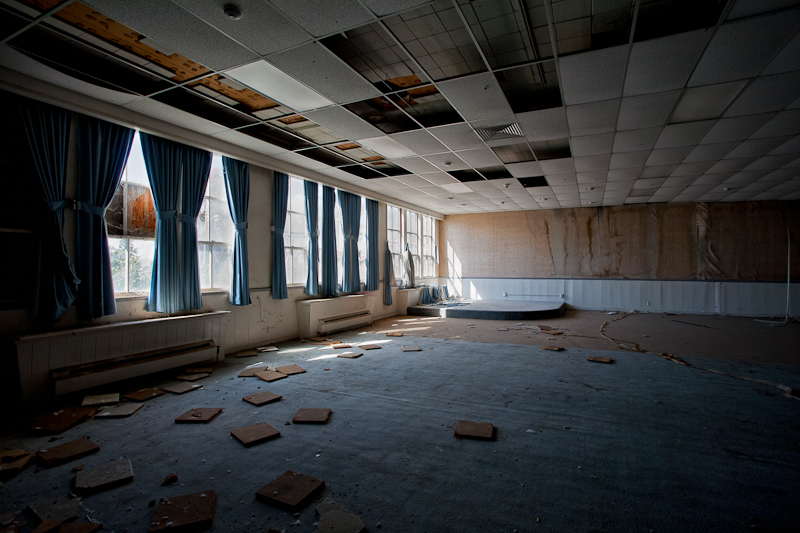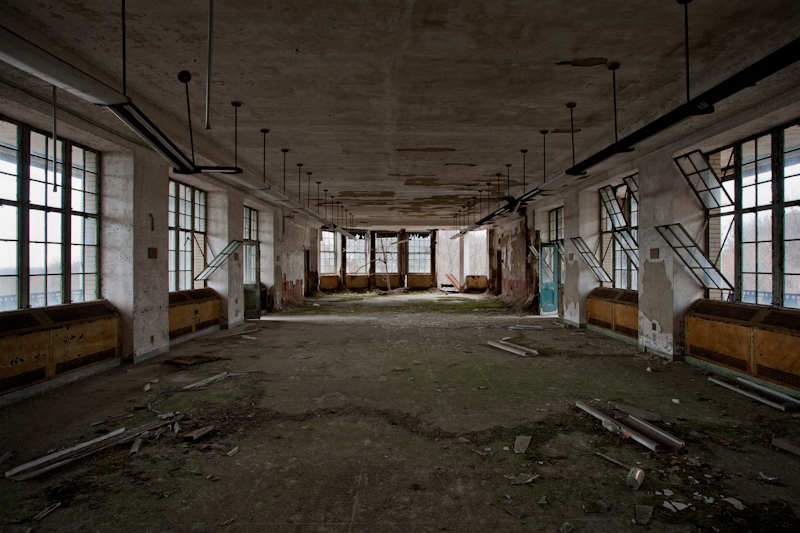Men's restroom inside the Heritage Inn at Rough and Ready Island in Stockton, CA.
Photo: "Threshold"

The Heritage Inn at Rough & Ready Island.
Rough & Ready Island went into operation beginning in 1944. It was also known as NSAS (Naval Supply Annex Stockton), a Navy supply depot and disposal facility that was built as an auxilary location to the Oakland Navy Depot.
Photo: "No Privacy Please"
As a patient at a Psychiatric Hospital, the privacy you entered the hospital with was virtually removed once admitted. Sleeping quarters were merely divided by short walls, showers did not contain curtains and many bathrooms were without stall doors.
Photo: "Porcelain Dancer"

Between 1944 and 1965, the Heritage Inn at Rough & Ready Island, an auxilary location to the Oakland Navy Depot, was built to house officers, their families, and visitors.
Alameda Naval Air Station
"Influx"
The Alameda Naval Air Station closed in 1997 due to the Base Realignment Closure Act, but it was once one of the largest, most complete Naval Air Stations in the world. She was commissioned in 1940, a little over a year before the United States became involved in World War II. During the war, the air station was a fully operating base with patrol plane squadrons and an Overhaul and Operations Department.
"Trailer Trash"
During the 56 years of service, the base had a population of 45,000, employing thousands of workers specializing in approximately 250 different trades in over 300 buildings.
"Zephyr"
Today, some of the old hangars and buildings have been repurposed by a few businesses, but most of the former base sits abandoned.
Photo: "Creep"
Building 93 at Kings Park Psychaitric was constructed in 1939 and was designed as a geriatric infirmary and drug treatment center. The design was such that the building had a very small footprint to allow for light to enter each room as well as the hallways.
Photo: "Dislodged"
Inside the auditorium of the former Heritage Inn on Rough & Ready Island.
Stockton's Rough and Ready Island went into operation in the early 1940's as an auxilary depot to the Navy Depot in Oakland. A few years later, the Heritage Inn was built to house the officers, families and visitors to the island.
Photo: "Sea Air"
Construction of the New York Sanatorium began in 1913. It consisted of eight pavilions, four men and four women's, arranged around an Administration Building, a Children's Hospital (shown here), a Rehabilitation Center, power plant, laboratory and Nurse's Buildings.
It was here at this hospital that the first treatment for Tuberculosis was discovered.
Photo: "Secured"
The Kings Park Psychiatric Center in Long Island, New York operated from 1885 to 1996. As patient populations began to grow in the early 1900's, the hospital began to expand. In the 1930's, the 13 story building, Building 93, was constructed. Upon opening in 1939, it became an infirmary for the geriatric patients and patients with physical ailments.
Photo: "Mammoth"
The St. Nicholas coal breaker once produced 12,500 tons of coal per day, but for the last 48 years she has sat abandoned.
Photo: "Beautified"
Left over beauty supplies inside the beauty salon at the Trenton Psychiatric Hospital, the first of the Kirkbride's established in 1848.
Photo: "Countryside"
Peeling paint and wallpaper found inside a recreational building at Hudson State Hospital.
Photo: "Dolled Up"
Found near the lower level dressing rooms at the Grossinger's Indoor Pool.
Photo: "Escape"
In 1931, the Philadelphia and Reading Coal and Iron Company's constructed the Saint Nicholas coal breaker in Gilberton, PA. The breaker was one of the largest in the world, with over 20 miles of track and 1.5 miles of conveyors. Each half of the building operated independently, but together they produced a combined total of 12,500 tons of coal per day.
The breaker operated for a number of years before closing in 1963.

















